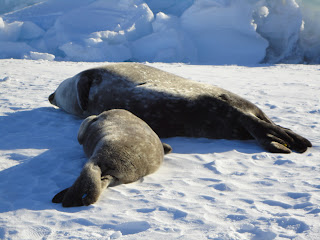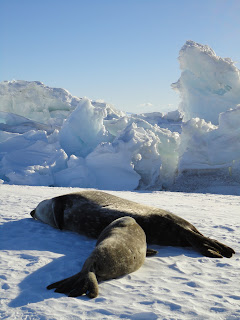This is a day in the life of Britt Driving to the Airfield.... thank you Plumber Walter and Shuttle Bill for the philosophical commentary!
Thank you for visiting Aaron and Britt Thompson's journal of our experiences in Antarctica! Things to expect: moments of geeking out on science, overly adjectived descriptions, and hopefully some good shots. Thanks again and blessings to you all wherever you may be on this beautiful planet!

McMurdo Station is in a frozen bay on the coast of the Ross Sea; Our home for the next four months
Friday, December 17, 2010
Pressure Ridges
The coastline of the Ross Sea has been an incredible place to explore since we've been here. On a recent trip out to the "Pressure Ridges" we learned how these unique ice-scapes are formed and how they're utilized by the Weddell Seals.
Pressure Ridges are formed when the Ice Shelf of the Ross Island (Ice moving from land toward the sea) collides with sea ice that is being pushed toward the land by ocean currents. The two sheets of ice collide together in a "rifting" motion similar to plate tectonics that formed the Sangre de Cristo Mountains. The collisions start out looking like frozen waves and over a short period of time, break at the top and push upward until they collapse. Some of the ridges get very tall (maybe 20ft.) and create beautiful, geometric shapes along the coastline near Scott Base (the Kiwi Station that's 3 miles from McMurdo).
The Pressure Ridges also create holes in the ice and a haven for Weddell Seals to come up out of the water and utilize the sun and open air. We saw a Cow and her pup along with a large Bull Weddell Seal. As we continued on, we heard a barking seal coming from behind one of the ridges. We walked around until we found a seal swimming around in an ice hole and announcing his presence. It was a great trip and awesome to learn more about this unique ecosystem.
Our buddy Nate getting a great shot
Thursday, December 9, 2010
Christmas Card from Aaron and Britt
 |
| Gila Wilderness in New Mexico |
Dear beloved friends and family,
We hope this letter finds you filled with joy and peace as we all
approach the beginning of a new year! We are so thankful to rejoice in the
Christmas season with you all! Just over a year ago, Aaron and I exchanged vows, danced with hoola-hoops, and celebrated the beginning of our life together as husband and wife. We have learned so much about each other, ourselves, the beauty of God, and the world around us. As we continue to learn and grow by the grace of God, we are so thankful for all of your guidance and love toward us. Thank you for being a part of our lives! Blessings and love from Antarctica this Christmas season!
Aaron and Britt Thompson
aandbthompson.blogspot.com
Psalm 121:1-2
“I look to the hills, from where does my help come from? My help comes from the Lord, maker of Heaven and Earth!”
Our first year of marriage has been filled with many blessings of memories together with friends, family, and eachother:
 |
| Antarctic glaciers |
 |
| The vast landscape of Antarctica where we built a cairn to honor my grandfather, Kenneth Snively |
 |
| Exchanging vows at the Goble Family cabin in the the Sangre de Cristo Mountains |
 |
| Chiricahua National Park |
 |
| Halloween in Ft. Collins - The old married couple... one month after we got married :) |
| Graduation in December - a huge honor to have my family all there with me! |
 |
| Our favorite 14er pose - seemed right for the big day! |
 |
| Grand Canyon National Park; on the Rim... it was 65 degrees in the bottom |
 |
| Saguaro National Park |
 |
| South Coyote Buttes on the Utah - Arizona Border |
 |
| Elk Hunting with Brandon, Dad, and Aaron in the Sangres |
pH sampling, Turkey Trotting, Dodgeball, and Ice Caves!
Hola from the land of ice and snow! We're enjoying a balmy day here at the beach! 35 degrees with Sunshine penetrating the thin ozone! An excellent day to get that strange grey tan that everyone seems to acquire without enough sunscreen.... A recap of what we've been up to:
After meeting a wonderful Marine Biologist named Gretchen, Aaron and I were invited to join a science group in a pH samples trip. The Hofmann Lab from Santa Barbara, CA is looking at dissolved CO2 in water and how it alters pH content in the ocean. These changes in pH directly influence marine life, specifically creatures called tetripods. The exoskeleton of these little creatures dissolve in low pH and thus can't survive outside of a specific pH range. Tetripods are a key species in the food chain here and thus are not only food but also an indicator species for the health of the ecosystem. This project is really fascinating because it's taking an enormous topic like Global Warming and addressing a very specific facet: an increase of carbon emissions in our air dissolves into the ocean and decreases (makes it more acidic) the pH of the marine ecosystem.
"Research in the Hofmann lab currently has four lines of research that are framed by understanding how marine organisms will respond to changes in temperature and ocean chemistry in the future. Our work is focused on learning more about species' resilience to these environmental changes and whether contemporary populations of marine invertebrates and their larvae have sufficient physiological plasticity to tolerate shifts in pH and temperature. " From the Hofman Lab website
Dr. Gretchin Hofman's lab website is fantastic! Check it out! http://hofmannlab.msi.ucsb.edu/
The hole in the ice where we helped take samples from
Paul, Dr. Gretchin's PhD student that we were able to spend the morning with
$200 grease for the equipment used to take water samples.... science is expensive.
Paul with the water sampling instrument that we helped lower into the ocean. The canister opens when a weight taps it from above and allows water from a certain depth to be sampled. This is done so that air from the surface doesn't influence the water sample.
Lowering the second part of the project into the ocean. This instrument measures temperature, pH, and other data that is used in the study. This device can be set to measure every 30minutes for weeks on end until it is taken up and the data is downloaded. All of this information is useful in answering questions about pH and its influences at different depths of the ocean.
Outside the warming hut - the weather was really cloudy and the horizon melted into the sky without polarized lenses on. The black rock feature in the distance is where Cape Evans is.
Giving the northern hemisphere a double high five
More cartwheels in the snow.... Aaron puts up with a lot.....
Getting ready for the "Turkey Trot" 5K race on Thanksgiving Day. It wasn't really Thanksgiving Day but all holidays are celebrated on Saturday here so that everyone can have a two day weekend. The race was really fun and a even better to run together - somehow we've never run a race together so this was our first one!Sidney - check out the pins on my vest - all from you! For those that remember my sensitive stomach in High School and College sports, that hasn't changed but this was a no-pressure race so no cookie-tossing this time around!
Flirting with the enemy..... The Shuttles Crew and the Fuelie crew fought hard through the second dodgeball tournament of the season but sadly, we're not as good as the Janitors or the Helo Techs.... Aaron rocked a fuel-line flag as a cape and I wore a grass skirt and a neon pink wig - the wig didn't make it through the first game.
We went on a Ice Cave trip one evening after work and were super thankful for our Big Red parkas! Blowing snow and wind that you had to lean into made the trip pretty epic, not to mention the beautiful ice cave that we were able to explore.
Blowing snow across the ice sheet. We took Deltas out to the cave and it was really nice to be a passenger and not have to drive for once! You can see the foothills of the Royal Society Mountains in the background.
The flag-line that we followed from the Deltas to the cave. There were crevasses beyond the flag-line that my camera case liner flew into..... that was a huge bummer to litter. Maybe a Skua bird is wearing it now as a hat.
Entering the Ice Cave!!! It was so beautiful!!!!
It felt like we were inside a cumulonimbus cloud that was covered with geometric shapes of ice. The ice had formed like cones and rods and flat pentagons. It opened into a small room and then narrowed in the back into a pale turquoise ravine. from a distance, the flakes looked like feathers of snow jutting out of the walls but up close, you could see the individual shapes and crystals. They were stunning.
Inside the Ice Cave.... and then my battery died.
A C-17 plane taking off. They're enormous. This is the type of plane that we both flew into McMurdo on. They carry huge amounts of cargo, fuel, equipment, the works, it's like flying inside a warehouse. The Air National Guard folks refer to these planes as the "Ice Princesses" because everyone is always excited to see them because they carry most of the mail and vegetables we get here. Plus, they only fly it the weather's perfect.
Subscribe to:
Comments (Atom)









































